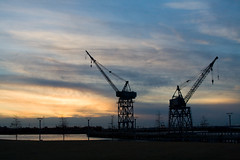
Image by Clay Larsen via Flickr
This week, we’ll celebrate Earth Day, the anniversary of the movement to protect our planet and conserve its natural resources, which began some four decades ago. Back then, climate change wasn’t even a phrase in our vocabulary, but today it defines the most urgent challenge we face.
Climate change is a global problem, but cities around the world are proving that the best way to address it is through local action. For example, Sao Paulo has become a leader in reusing waste to generate electricity. Jakarta and Johannesburg have established excellent bus rapid transit services, which encourage more people to use mass transit, and Hong Kong has made a major commitment to reducing the use of coal for fuel.
Here in New York we’re making great headway on the sustainability plan, called PlaNYC, that we launched on Earth Day four years ago. This week, we’ll update and relaunch the plan – a step that will happen every four years because we can always push ourselves to do better. Since the plan was released, we’ve made tremendous progress toward its goals. Two of the biggest are: reducing our city’s carbon footprint by 30 percent by the year 2030; and giving New York the cleanest air of any major American city. Reaching these ambitious targets requires a continuing commitment to action, and we are turning that commitment into a reality.
For example, last week we released the results of a study that shows a marked improvement in the air quality of formerly one of the most congested areas of our city: Times Square. The results of our first air-quality survey, released at the end of 2009, showed that concentrations of two pollutants in Times Square – nitrogen dioxide and nitrogen monoxide – were among the highest in the city. However, last week’s report shows sharp drops in these pollutants of more than 40 percent and 60 percent, respectively. The crucial driver of this change has been the pedestrian plazas we established in Midtown in 2009. We made these improvements to straighten out some of the chokepoints in our street grid and to help traffic flow more smoothly and quickly. But we also expected that by reducing the numbers of vehicles in and around Times Square, we would improve the area’s air quality – and we absolutely have.
Of course, we continue working to improve air quality in all of our city’s neighborhoods. And that’s why last week we began working to establish a cleaner energy source for ships docking at the cruise terminal in Red Hook, Brooklyn. Right now, when cruise ships are in berth at the terminal, they continue to use their engines to run heating, air-conditioning, and electrical systems. The engines are powered by high-sulfur diesel fuel that releases what is called “particulate matter” into the air, which can trigger asthma attacks and other respiratory conditions. Now, through a partnership with the cruise lines, we’ll introduce a mechanism to allow the ships to turn off their engines and plug into the city’s electrical grid while in port. This will help reduce air pollutants, and also cut down on the carbon emissions that contribute to climate change.



Leave a comment